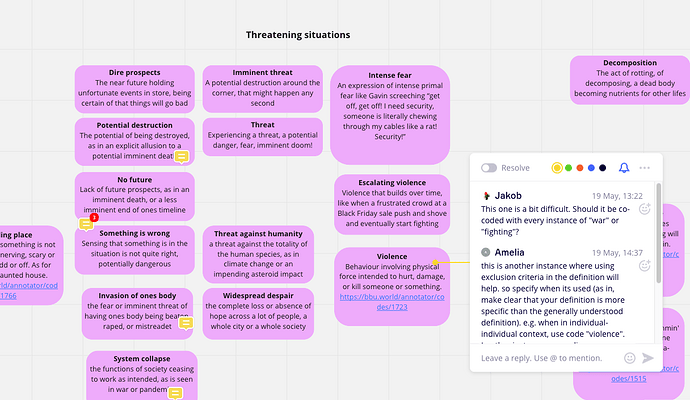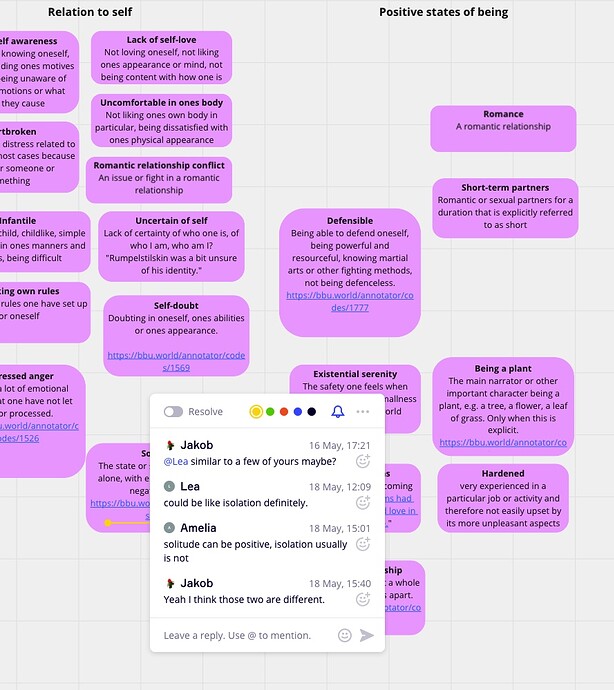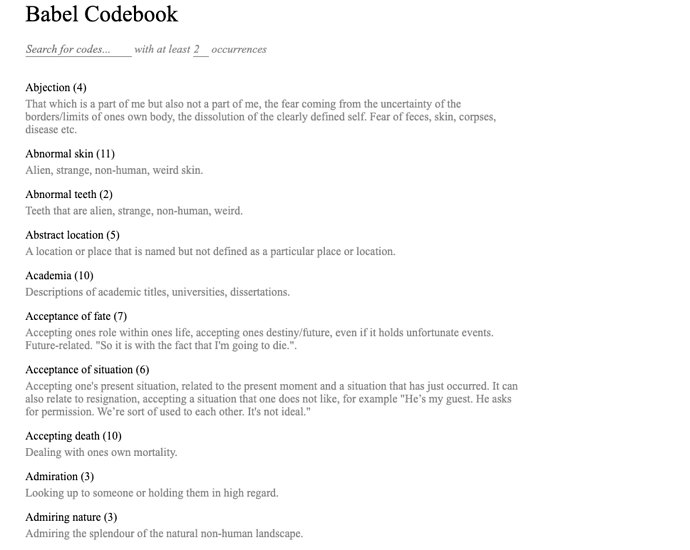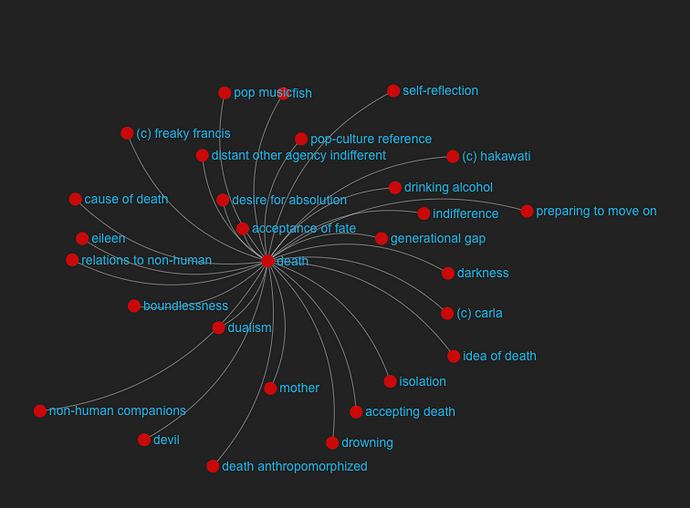Hi all from the ethnography team in Babel Between Us. Here is a recording of a meeting where we explained our process and our findings from the first iteration of the project:
Below you’ll find our first writeup. This is meant as an explanation of our process so far: what ethnographic coding is, the thought processes underpinning our coding, what the graph of the codes means to us at the moment, and what we think it could mean for the writers.
There’s also a video explaining a lot of the ethnography and semantic social network analysis in real-time, which is a great clarifying companion to this post. Depending on your preferred style of receiving information, you might prefer one to the other, but we’d recommend checking out both!
Contents:
1. What is ethnographic coding?
2. Explanation of different approaches to coding by each ethnographer
3. Strong Relations in the Graph
4. Exploring the Graph: Expectations and Surprises
5. Usefulness of the Graph
What is ethnographic coding?
Ethnography is an interpretive practice aimed at understanding people’s worldview from their own perspective. It aims, through in-depth engagement in the social worlds of participants, to detail collective modes of thought, imagination, and shared understandings. Ethnographers do this through “deep hanging out” in the spaces of those they study.
First, some background on the ethnography team’s (@amelia, @Bojan @hugi @jakobskote @lalalua’s) process: we read (and reread and reread) the stories posted on bbu.world. Then we develop codes (aka “tags”) that we assign to sentences or paragraphs of the threads that interpret the content of the stories unfolding. Sometimes these codes are “in-vivo” reflections (direct quotes from the stories), sometimes they are words or phrases we come up with that are salient, summative, or essence-capturing. We keep these codes in an ever-evolving codebook, where we comment on each other’s codes and constantly update them based on feedback and collaboration with the team. We also have bi-weekly calls in which we discuss the codes and stories in more detail.
As @jakobskote puts it: The ethnography plays many roles within this project. One of them is to explore if the ethnography can be an aid to the collaborative process among the writers. In this sense the ethnographers become a part of their creative process, by providing a constant reflection of the collaboration. The texts are the only representations of the collaboration that we have access to. By treating these texts as a subject of ethnography in itself, the ethnography focuses solely on the results of the collaboration, and does not take into account outside influences and the writers’ individual personas. The texts are in this way treated as a representation of the writers’ collective consciousness, in its own right.
And as @lalalua reminds us: Coding itself is a long process based on constant revision of assigned codes (changing the names of the codes and text it relates to). The graph of codes actually shows only the final selection and connection of codes but not the history of the coding process itself and different interesting negotiations happening throughout that task (the first iteration of which lasted over a month).
You can see the codebook in an organised, searchable form at https://codes.bbu.world/. If you’re ever wondering about the definition of any of the codes, this is where to go!
Our codes are then automatically displayed in what we call a “semantic social network”, which is basically a graph visualisation of the codes based on how often they co-occur (so, how frequently two concepts appear together in the same post). The idea is that the graph both shows you what people are talking about (concepts) and who they are talking to (which writers are writing with each other about those concepts). Some of these codes are concrete things, like “plants”, whereas others are more abstract concepts, like “lack of self-love” (amusingly, these co-occur in some of your stories). You’ll see many pictures of the network graph in this post!
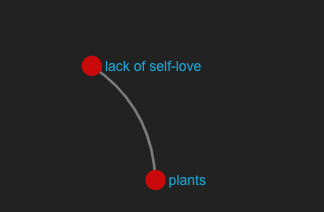
You can also see the codes that have co-occurred with a specific code, if you’re interested in exploring what concepts have been most frequently connected to one concept in general (e.g. “death”):
If you want a more detailed guide to ethnography, ethnographic coding, and semantic social network analysis, feel free to check out this primer/course @amelia made for beginners.
Different coding processes
Ethnography is an interpretive process, and requires reflexivity. Everyone views the world from a certain place. We want to each explain how we initally approach the coding process.
@Bojan takes what he calls a “psychogeographical” approach:
I’m interested in a “taxonomic” approach to coding. I’m trying to imagine the BBU world created through texts as a conceptual whole even though most of the threads are narratively not connected. In this approach, I’m more interested in the peripheral view – in things, and frames created for the sake of the individual narratives. When I code, I ignore the narrative and try to map (and count) different aspects of the created world: body, mind and space related issues, places and different beings living there, home hardware, profession of the character, emotions and feelings (produced along the narrative way), properties such as colors of furniture or clothing mentioned in texts.
My first coding attempts were inspired by artistic practices such as psychogeography (focused on connection between emotions and build environment) and it could be compared to the process of mapping. From that perspective, text is perceived as territory inhabited with meaning. Most of my codes are then like boxes or containers, categories for the catalogue of the materiality of the created world. But it shouldn’t be a rigid catalogue – it could, for example, show the exploded view of the “anatomy” of the collective body created through the process of writing (with both – human, and non-human body parts).
I see this approach as a tactic for tackling the pandemic context of first iteration in somehow indirect (and almost absurd or at least surreal) manner. How is this time of new common normalities reflected into details of common fiction? Is there a relationship between official, restrictive approaches to the hygiene procedures and individual notions of (un)cleanliness and perception of our bodies? How do we perceive our physicality – which parts of the body become more significant; is it by chance that hands are mentioned so many times in different threads and that I’ve managed to count around 50 different body parts mentioned in different threads (sometimes in the spotlight, sometimes hidden and marginal)? The lockdown has affected all of the project participants, writers, hosts, ethnographers – our everyday working spaces have overlapped with our living rooms, bedrooms, kitchens (even more than before). Windows and doors highlighted the physical borderline between threatening outside and sheltered insides and became oft-mentioned parts of building infrastructure. In many cases narratives were placed in familiar but transformed spaces of characters’ bedrooms, hallways and living rooms.
@lalalua (Lea) takes a more topical approach, lead by some of the central themes she noticed in the stories:
My coding process is based on several key topics I encountered in reading all of the Babel posts. I detected three topics that I further develop through interrelation between other added codes. These topics are: pandemic, the non-human and relationships. These topics (simultaneously they also function as central codes) are spatially choreographed and correlations with other codes are explored. In that way I map out how these topics are interpreted by the writers but also how I inscribe new potential meanings into them.
As my approach was topic-based I can see connections which have a logical link to some very present topics. This is visible in the example of connection between pandemic, escape and sanitize or death and darkness.
@jakobskote takes a keener interest in how writers are expressing and constructing their worlds, specifically looking at all the different objects that the writers use to build up their narratives:
In my process of coding I am looking for what specific elements the writers use to construct their texts. These might be corporeal objects like “cat” or “orchid”, incorporeal objects like “recurring dream” or “climate change”, actions like “derision” or “excitement”, states of being like “stagnation” or “being a plant”, and lastly meta elements like “military jargon” or “change of narrator”. I apply a democratic view on these objects and does not premier one before the other, which result in many codes per post (ca 25/post), and a slow process.
@hugi and @amelia come from different interpretive backgrounds, but approach coding similarly – wide open, trying to jump into the stream of the text and code from there. As a result, we often find ourselves in the deep end making links like a nutty, obsessive crime scene wall ![]()
From here on out we will speak in a collective voice, which emerges from the merging of some of our interpretations of the coding process, the semantic social network graph, and the interpretive practice of using both tools to navigate the stories.
Strong relations in the graph
There is a very strong correlation cluster around “pandemic” that also came out very prominently when reading the fiction. Anything else at this point in time would be surprising. There are strong connections from pandemic to terms like “confinement”, “isolation” and “sanitize”. That this theme has featured so prominently makes the body of text really interesting from the perspective of mirroring this period in human history – the year when we found ourselves globally connected in real-time over a single common challenge. Confinement is connected to “measure of time”, a code used for explicit mentions of time passing. This is also unsurprising for anyone who has lived through the last few months. Confinement is also strongly related to “food”. These connections are very obvious to us now, but if seen by someone waking up from a year-long coma, they might need some explaining. This is a good reminder of how things that are “obvious” are still interesting.
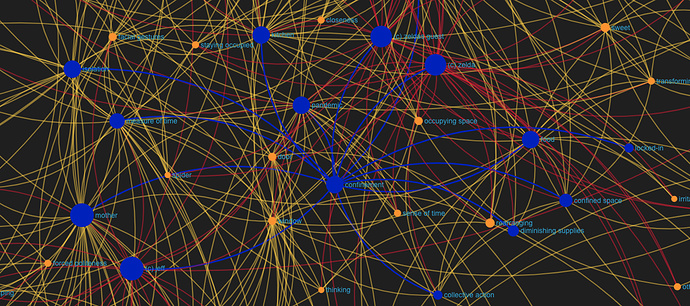
Another concept that feels apt for this period is “death” which is a very centrally connected node. Its strongest correlations are to “darkness”, “accepting death” and “dualism” and more surprisingly to “non-human companions” and “pop-culture reference”. Death is also strongly correlated to “isolation”, which seems to indicate that there is a connection between the narrative focus around the pandemic and the exploration of our relationship to death.
That death is connected to concepts like “pop-music” and “pop-culture reference” can be understood by exploring that connection. This strong connection comes from two threads, “He Was A Fire Sign” and “A Mind Adrift on the Ocean”, and the strength of the connection is because many of the contributions used these themes together.
There are also codes that are unsurprisingly connected that do not carry much meaning. That hair is connected to the head is not exactly the most exciting discovery of the year.
Around “mythology” there is a cluster of codes that carry a lot of meaning but that are largely unsurprising. Mythology is correlated to mythological actors like “kaggen”, to mythical tropes like “firstborn child”, “foreseeing the future”, “ancient artifact”, “devil” and “destiny”. There is also a strong connection to the idea of “reimagining myths” which is largely unsurprising in the context of myths in collaborative fiction.
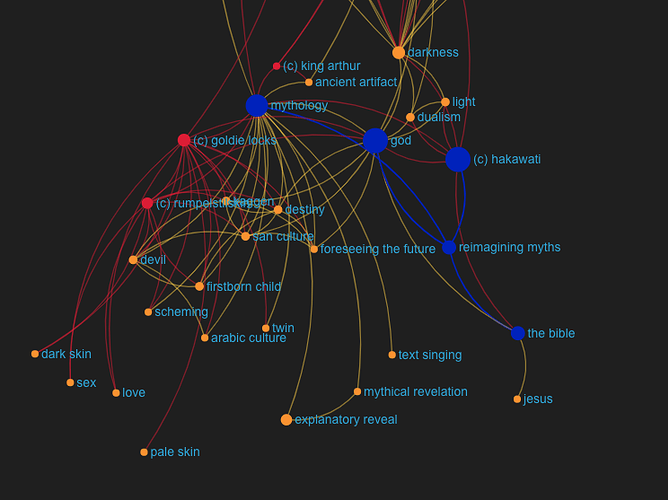
Mythology is in turn connected to “god”, which in this context means “the almighty God”, rather than a god in a pantheon. This connection is also largely unsurprising. God connects to more “dualist” concepts like light and darkness, and to death.
Another cluster of strong connections forms around the concept of “mother”, and most terms that correlate strongly are either neutral (like “body position”, “window” and “measure of time”), indicative of a problematic relationship (“lying”, “madness”, “panic” or “cruelty”) or indicative of a character going through an inner process (“self-reflection”). There is a noticeable absence of strongly correlating terms around safety, kindness, and care around the concept of mother. Many of the strangest negative connections come from a single thread (“Where is Quarantine”), where the mother figure is demonized. In another thread, “A Mind Adrift on the Ocean”, the mother figure is not described in a negative light, but the memories of the mother are brought up during a difficult experience. In this case, a limitation of SSNA is revealed – that it’s not possible to conclude any connection between concepts, just that they have appeared together. This is important for the writers to understand as they explore the graph.
From the character network, we can see that there is a bit of spill-over of characters and concepts happening between certain narratives. At this point in the ethnography, The character network is possibly more able to unearth some common themes that appear because of the strong correlation of certain characters with shared concepts.
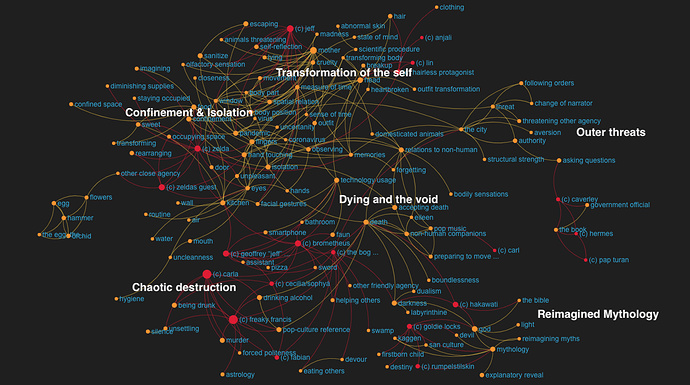
This picture shows some emerging themes, but there are also themes are missing in the graph but very present in the narrative. For example, the reimagined mythology texts have a prevalent theme of relationships, intimacy, and sex that does not show up in the graph. Similarly, the context of many confinement stories is dealing with interpersonal relationship dynamics that don’t show up in the graph at this correlation level.
Exploring the Graph: Expectations and Surpises
Easily Understood Connections
There are a lot of connections around pandemic and quarantine related concepts that are not very surprising. In our ethnographic process we have started with the longer, more popular, threads, out of the assumption that these might better reflect the shared consciousness of the writers. This is certainly true in one respect, but it’s a problematic assumption because of the fact that these threads have in many cases a comparatively lower threshold of entry. One example is the diary-style threads that follow no stringent framing or narrative, which allows the collaborating writers vastly more entry points than for example a very narrative-driven crime drama. The diary style threads tend to touch on the topics of pandemic and quarantine, which comes of no surprise given the ongoing pandemic. Given the length and the popularity of these threads, the concepts related to pandemic and quarantine are then coded more often than less numerous topics, giving them their prevalence within the network.
Surprising Connections
We are still in the early stages of the project and the analysis, so there is yet much more data to be gathered to find the really juicy stuff. One thing Jakob in particular is trying to see is how, and if, various topics, writing styles, and ways of framing a story, lends itself to different kinds of collaboration. He has yet not gotten enough data to get any proper answers to this question. There are also plenty of occurrences of non-standard ways of writing throughout the texts, for example stage directions, visual concrete poetry, and writing with a scientific language. It will be interesting to see how these codes correlate with other topics down the line.
What has been surprising is the many occurrences of characters wanting to be, being or turning into nature and plants, and other subjects within the wide sphere of queer ecologies and non-dualist views of nature. This could be related to the ongoing coronavirus pandemic, which has highlighted our human world’s saturation with non-human agents, and forcing us to rethink our delineation of the human. Jakob is currently researching these topics in other contexts, so he feels he is naturally biased in looking for them here as well.
Rather than saying that the forest is the trees or the network between it, it is more true to say that the conversations really are the forest.
I watch a whale falling towards me, a shadow-body. I watch it as it comes closer and closer to me. I long for the big carcass to cover me with its pressure, months pass, years like this. I become a part of the ocean floor, seaweed covers me while I wait.

An interesting aspect of these explorations of queer ecology is that they do not fall in the pastoral traps that sometimes surround this subject. Instead, they explore the inherent violence and darkness of an interconnected nature, where both parasitism and eating others are a necessity for survival. This, we also assume, does probably stem from the fact that we are all painfully aware of the possibility of our bodies being turned into hosts for a hostile, and potentially lethal virus.
There goes Narcissus—heart perfectly broken, jaw and eyes still just ordinary. We tell him:
spend the night, there is no shame in being wrong,
sink into our murky floor—young bright things shouldn’t drift and drain their own blood. Spend the night.
His surrender is a quiet one.
They have their own symbiotes; there is a forgotten ecosystem of parasites, which march through bodies like a macabre parade, each consuming the offal of the other.
The host, naturally, remains alive until the very end of this process.

There is an inverse exploration of the same topic centering around various instances of bodily transformation/mutation and abjections, which inherently disturbs conventional conceptions of identity. Again, we assume these explorations stem from the coronavirus pandemic, which has forced us into a collective reconsideration of the solidity of the concept of the human. These bodily transformations/mutations most often seem to revolve around the skin, the physical border of our flesh against the outer, non-human world, which points at an exploration of the permeability of identity.
He scratched his upper right arm were the skin had peeled away to reveal the crystalline structure beneath.
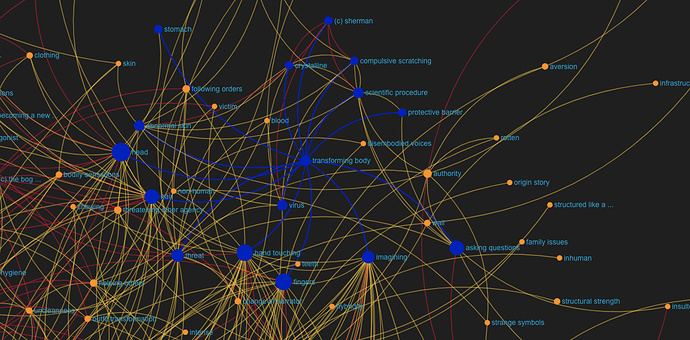
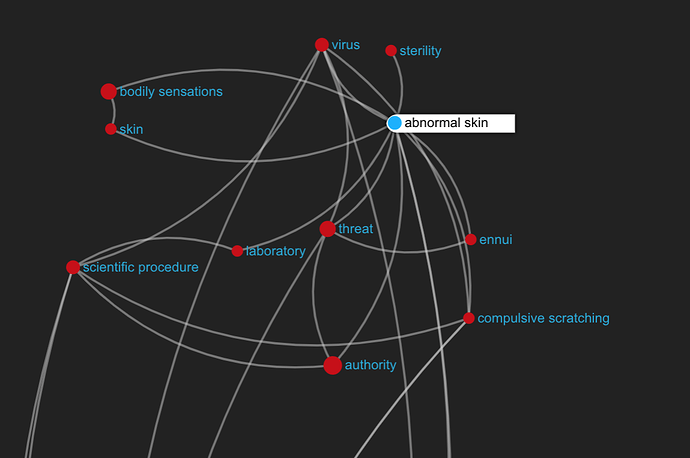
There is also an interesting connection between bodily transformations/mutations and hair. Our speculation is that this is due to hair being a peculiar object, being both a body part and a fashion statement. A physical part of our body, who’s growth we cannot control, while at the same time being an individual, and infinitely customizable, signifier of identity. The fact that our internal bodies can be affected by non-human actors isn’t as abjective as it is not visible, the real fear lies in a virus that affects how we present ourselves to the world. The coronavirus does not affect our appearance apart from requiring us to wear facemasks, but the situation triggers cultural memories of earlier, more visually disturbing, diseases.
A haircut that does not flatter and that cannot be mended is a helpless feeling. There was nothing to be done. Hands were tied. No amount of blow-drying or gelling could help now. The shape was here to stay, at least for six weeks. Six excruciating weeks.
Apart from stemming from the ongoing pandemic, we believe these topics are a part of an ongoing cultural questioning of the human/nature divide. This, one could argue, is a collective cultural processing of the much bigger ongoing catastrophe, the climate breakdown. When looking at the code “climate change” in the graph, the code it most often co-occurs with is “devour” (however, it has only been applied once, so this finding does not indicate a strong connection.)

Tracing body connections in the graph also shows, for example, that “uncleanness” and “cleanliness” are connected with “eyes”, but (from some reason) only uncleanness is connected with “mouths”. Cleanliness is associated with more passive body positions such as sitting and with bed, and uncleanness is associated with door and threat on the one side, and with making decisions and helping others on the other side. Maybe we could say that it’s predictable to associate domain of clean with the safety zone of bedroom, and domain of dirt with the threat that comes from the outer side of doors, but it is interesting that uncleanness comes together with more active notions (decisions making and helping). Maybe there is an implicit connection between will needed to open the doors, and way of handling the risk in the act of helping the others.
What do we think the graph is useful for in the context of the BBU project? How does it help us explore the stories?
The purpose of the graph in the context of the writers is to act as a map over the landscape of the texts, and in this sense a map over their collective consciousness. It is also not a map in the sense that it does not claim to offer an objective, zoomed-out view — instead, it is an interpretation, based on woven-together, iterative, collaborative ethnographic work. We can think about it as an evolving conversation that also acts as a navigation tool.
In a basic way the graph is a non-dimensional representation of all the narratives, in the sense that the concepts, displayed in a network, don’t follow a predefined progression. Text is, in most cases, inherently 1-dimensional in the way it is experienced, you read a text from left to right and does most often not depart from this linearity. The content proliferates in a multitude of directions as soon as it has entered our mind, but the way in there is a one-lane, one-way bottleneck.
A story told through a graph turns this on its head. While losing the intimacy of the text, it instead allows the reader to get an overview of the narrative that is not visible from within the text itself. As Open Ethnographer shows connections between codes applied to the same post, some unwanted connections will occur (for example a flower appearing in the beginning of a post being connected to an act of cruelty happening at the end of it.)
The graph does neither distinguish between different narratives, instead it regards all narratives as expressions of the same collaborative process. Themes that occur among one group of writers can appear among a different group of writers, and then be represented as the same theme in the graph. This allows us to look at the themes specifically, and not who is writing about them, which gives a clearer view of the collective consciousness, that is not clouded by the presence of individual writers.
When looking at the strongest correlations in the graph, it can be reaffirming that there are in-fact some “high level” overlapping themes. This can help us orient ourselves in the shared imagination and understand where it overlaps and where it doesn’t.
When looking also at the weaker correlations, the graph can be suggestive for themes to weave into future narratives. In a solitary creative process, we build internal worlds and maps of what we are exploring. As connections emerge in our creativity we can notice them and reinforce or deconstruct those connections. When filtering the graph to include a weak connection that could emerge if reinforced, it may be possible for us to immerse ourselves in a shared subconscious imagination.
Finally, the graph also tells us which concepts we have explored together with others. That can also help us understand who we are not working with, and which concepts we are not engaging with, allowing us to either reinforce or question those patterns.
We can use the analogy of a natural landscape. Reading a story is taking a hike through the landscape, while looking at the graph is looking at the map of the landscape. By only looking at the map you can never gain the depth, intensity and intimacy of experience that you get from the hike. On the other hand, if you go for the hike without the map you will end up easily getting lost or only walking the most beaten and obvious path. The map will help you find parts of the landscape which you have not yet explored, and didn’t know existed.
The graph enables us to see the links between certain concepts that are not necessarily noticed while reading specific stories. In that way it opens new interpretations of some charters/concepts or it opens space for completely new stories that can be written in part based on these links. It highlights different otherwise invisible textures that could come to life in upcoming writing iterations.
Hopefully, the graph can play a similar role for the writers, by allowing them to get an overview over the totality of the content on the Babel platform, and positioning themselves within it, to see what white spots occur, what parts of the collective consciousness they have not yet traversed.

